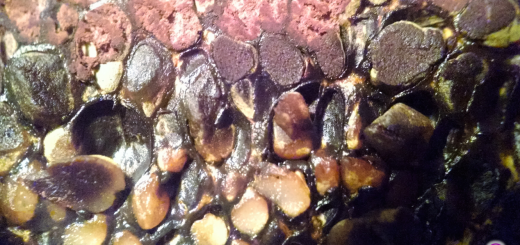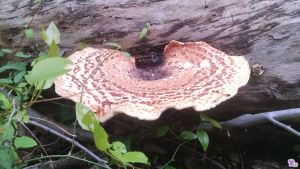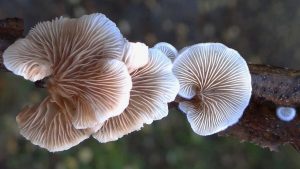#029: Mushroom Morphology: Chanterelles and Trumpets
This morphological group of mushrooms is defined by the presence of blunt ridges rather than true gills. These ridges can vary from well-developed, gill-like structures to small wrinkles on a nearly smooth hymenium (spore-bearing surface). Another defining feature of the chanterelles and trumpets is that the hymenium is always decurrent. This means that the ridges run down the stipe/stem, often going all the way to the ground. Chanterelles usually have a pileus (cap) that is flat to depressed in the center. The mushroom that defines this morphology is Cantharellus cibarius, commonly known as “The Golden Chanterelle,” or simply “The Chanterelle.” Trumpets, which are a subset of chanterelles, usually have a nearly smooth hymenium and are distinguished by an extremely depressed pileus, which results in the trumpet/vase/funnel shape of the fruiting bodies. This morphology is best illustrated by Craterellus cornucopioides and its almost indistinguishable American relative Craterellus fallax. Commonly known as the “Black Trumpet,” “Black Chanterelle,” “Horn of Plenty,” or (in France) “La Trompette des Morts.” Despite the ominous French name, this mushroom is actually a good edible. Most chanterelles are mycorrhizal with certain trees, although there are also a number saprobic species (especially in the genus Craterellus). Despite the presence of many good edibles in this group, the ecology of many chanterelle species is poorly understood. The Black Trumpet, for example, is possibly saprobic, probably mycorrhizal, and potentially involved in some type of association with moss. No one is exactly sure what its ecological role is.
Like most fungal morphological groups, the chanterelles are polyphyletic and thus do not relate to any coherent taxonomic grouping. There are three main genera of mushrooms with a chanterelle morphology: Cantharellus, Craterellus, and Gomphus. The first two genera are both found in the order Cantharellales, which also includes some coral fungi and toothed fungi. Modern advances in genetic sequencing have resulted in a vast reordering of Cantharellus and Craterellus. Many of the morphological characteristics traditionally used to separate the two genera have proved unreliable. Cantharellus cibarius and Craterellus cornucopioides/fallax have remained in their respective genera (although there is now confusion over whether or not C. cornucopioides and C. fallax are separate species). However, if you find a chanterelle with a morphology somewhere in between the two, you will likely find multiple names for the same fungus. The genus Gomphus belongs to the order Phallales, which also contains the stinkhorns. There is also one outlier: Polyozellus multiplex. Polyozellus is a genus which contains only one species: P. multiplex. This mushroom is rarely encountered in North America, but is apparently common in Korea. Field guides often include two agarics in the chanterelle section: Hygrophoropsis aurantiaca (FFF#196) and Cantharellula umbonata. Both have small, decurrent gills that make them visually similar to the chanterelles. All of these mushrooms are placed in the phylum Basidiomycota.
Now for the part you are probably most looking forward to: edibility! None of the mushrooms in Cantharellus or Craterellus are poisonous, and most are edible. Of course some taste better than others. Cantharellus cibarius (“The Golden Chanterelle”) is the most widely eaten chanterelle. It has robust fruiting bodies and a good flavor. Lucky for you, it is widely distributed in North America*! It can be found in the summer, sometimes fruiting gregariously in so many numbers that you can’t possibly pick them all. When you are hunting for the Golden Chanterelle, make sure to compare your find to Omphalotus illudens, which is also orange, has decurrent gills, and is often found fruiting on the ground. For more information on O. illudens, including how to distinguish it from chanterelles, see FFF#007. Another good edible is Craterellus cornucopioides/fallax (“The Black Trumpet”). The flesh on these mushrooms is very thin, so you need to collect a lot before you can make a meal out of them. This task is made even more difficult by their color. For some reason the black fruiting bodies are almost impossible to see on the forest floor. If you don’t find enough trumpets to make a meal, I think these mushrooms taste good enough on their own that you can dry them out and just eat them as chanterelle chips. Polyozellus multiplex is also edible, although you are not likely to find it in North America. However, if you’re ever in Korea make sure to keep an eye out for roadside stands selling P. multiplex! Mushrooms in the genus Gomphus are considered “edible for some”. They contain various gastrointestinal irritants and should therefore be generally avoided. Apparently some people can eat certain species of Gomphus with no ill effects, but if you would rather avoid the symptoms of food poisoning, do not eat Gomphus species.
This post does not contain enough information to accurately identify any mushroom. Never eat any mushroom without using a field guide to identify it. If you need a free, quality field guide, I recommend Michael Kuo’s MushroomExpert.com. For more information on the chanterelles mentioned above, see below.
* More likely, Cantharellus cibarius is not found in North America. Instead, there is probably a species group of a number of chanterelles all closely related to C. cibarius. What does this mean for you? Not much. Any species of chanterelle that keys out to C. cibarius in a field guide will be edible and have a good flavor (again, remember to compare your collection to O. illudens).
See Further:
http://www.mushroomexpert.com/cantharellaceae.html
http://www.mushroomexpert.com/phallales.html
http://books.google.com/books?id=zjvXkLpqsEgC&printsec=frontcover&source=gbs_ge_summary_r&cad=0#v=onepage&q=cantharellacae&f=false (edibility information)
http://www.mushroomexpert.com/craterellus_cornucopioides.html#konradii (Black Trumpet)
http://botit.botany.wisc.edu/toms_fungi/july98.html (Black Trumpet)
http://www.mushroomexpert.com/cantharellus_cibarius.html (Golden Chanterelle)
http://www.mushroomexpert.com/polyozellus_multiplex.html (P. multiplex)
http://www.mushroomexpert.com/taxonomy.html (taxonomy, note that Gomphus is incorrectly placed)
http://www.mushroomexpert.com/glossary.html#falsegills (on distinguishing chanterelle ridges from true gills)
http://www.mushroomexpert.com/omphalotus_illudens.html (O. illudens)
Keep up with FFF to learn more about chanterelles!








![#011: Characteristics of Kingdom Fungi [Archived]](https://www.fungusfactfriday.com/wp-content/themes/hueman/assets/front/img/thumb-small-empty.png)



3 Responses
[…] gilled mushrooms, most notably Lenzites betulina, the “Gilled Polypore” (FFF#168). The order Cantharellales has also produced species with well-developed, gill-like ridges, although these mushrooms are […]
[…] both cases, the mushrooms are considered to have ‘false gills’. The order Cantharellales (see FFF#029) has also produced species with well-developed, gill-like ridges, although these are blunted and […]
[…] associations with trees (see FFF#075 for more). Examples from this group include amanitas, chanterelles, and boletes, just to name a few. A surprising number of basidiomycetes are insect pathogens, but […]